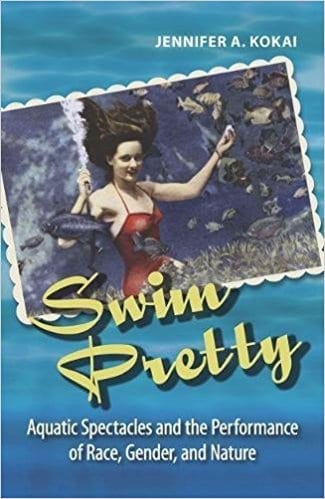Jennifer A. Kokai is a name that pops up regularly in the UTBA archives as a director. A faculty member at Weber State University, Dr. Kokai is also the author of the new book Swim Pretty: Aquatic Spectacles and the Performance of Race, Gender, and Nature. Dr. Kokai was kind enough to answer a few questions I had about her book.
 UTBA: Can you please tell me what your book is about?
UTBA: Can you please tell me what your book is about?
Kokai: The book looks at how performances in water, especially those featuring people performing as mermaids, began in the United States and how they have changed, or haven’t changed, over time. It turns out that from 1939 until now, water spectaculars have used mermaids to make the underwater world seem safe, nostalgic, romantic, and fun. While these water performances can be really entertaining and fun, the idea that humans can control the oceans and those who live in them is dangerous. It leads to things like putting humans in the water with orcas—apex predators—and then people die, or taking the ocean for granted and not understanding its actual impact on our lives. In the book, I look at the 1939-40 New York World’s Fair and Aquacade, Weeki Wachee in Florida, Aquarena Springs in San Marcos, TX, and SeaWorld.
UTBA: Your book covers decades of these aquatic spectacles. What do they tell us about American society and how it has changed over the years?
Kokai: One of the interesting things I discovered is that mermaids, at least, haven’t really changed over the decades. We still imagine them very similarly to how they were portrayed at the 1939 New York World’s Fair. We’re still far less comfortable with men in tails than women. We still imagine mermaids largely as traditionally attractive white women. They still rely on nostalgia, hiding technology, and romance, things that I call “an aesthetics of descension.” What has changed is water itself. The ocean is growing more acidic and more extreme weather incidents are occurring. A lot of the animals in these performances are becoming endangered. We’re also dealing with a lot more droughts and higher temperatures in places where water parks and aquatic spectacles are popular. This is having an impact on how water parks, like Sea World, design rides and build shows.
UTBA: These mermaid shows and aquatic spectacles don’t seem like plays in the traditional sense. Why would a theatre professor research these types of events?
Kokai: My PhD was actually in “Performance as Public Practice,” and I was trained in both theatre history and performance studies. Performance studies often looks at things that fall outside of traditional theatre’s scope. But really, even though these are shows being put on in water and the actors are not always human, it’s all still theatre. There’s a script, there are lights, there’s sound design, there’s costuming, there’s acting. It’s just that some of the acting is by pigs or whales.
UTBA: Pigs? How do pigs fit into water spectacles?

Ralph the Swimming Pig at Aquarena Springs.
Kokai: So all four of the water spectacles I write about are amusement parks, essentially. And even though all of them claim to be (or have claimed) about education or ecology, they’re all for profit. Which means that introducing novelty to tourists becomes a factor. Ralph the Swimming Pig was introduced at Aquarena Springs when the sea lions they had got very, very sick (salt water animals don’t like freshwater springs). They figured out a pig could swim (as a baby), and trained pigs to be in the show. Ralph became on of the most popular things at the park and synonymous with Aquarena Springs. Which does not exactly teach people about the history or ecology of freshwater springs. But it did sell tickets. When Ralph got too big to swim (around 9 months) . . . well, the park made excellent BBQ.
UTBA: Of course, the most famous mermaid stage story is Disney’s The Little Mermaid, which UTBA reviewed two productions of this month. What insights does your book bring to popular stagings of mermaid stories?
Kokai: The stage version is a really interesting beast because you can see Disney Theatricals working to update it for the contemporary times but still give people what they expect. A few things you often see in mermaid performances that show up in The Little Mermaid are a contrast between the land, which is industrious and has technology, and the underwater world, which is depicted as lazy and fun “up on the shore they work all day… while we devotin’ full time to floatin’.” Unfortunately this often gets connected to stereotypes of people from the Caribbean or South Seas as lazy or uncivilized. In mermaid shows, you also often see people of color absented, or turned into animals (Sebastian the Crab, for example). Even though mermaid shows use music or ideas inspired by other cultures the people are usually all white. And of course the mermaids are all fabulous and hyper-feminine, you rarely see ugly mermaids, or mermaids who just don’t care about how they look and want to wear a ponytail and a comfy t-shirt.
UTBA: You’re right about mermaids always being trim and white. I noticed that Netflix has not one, but two mermaid TV series (Mako: Island of Secrets and H2O). Almost all the mermaids in the publicity photos are white, athletic, trim, and there’s a clear female majority. Is this a conscious decision from creators of mermaid shows? Is it a lack of creativity? Or are they just giving their audience what they want?

Weeki Wachee.
Kokai: Historically it was a conscious decision. Weeki Wachee opened in Florida when Florida was still entirely segregated and hostile to non-white folks. Now I think it is unconscious. When people think of mermaids, they default to this old tradition, and culturally we think of having a tail or performing as a merperson as not being very manly. In part, I argue, because of this association between under water and femininity. There’s a reason the cartoon Triton, though old, has really upper body muscles to offset his tail. Right now, however, mermaid performance is a super big trend and we’re starting to see all kinds of people claim a space in it. Men, people of color, and the transgender community all have written about the importance of mermaids to them. Maybe we’ll see that reflected back on stage and in media. My understanding is the remake of Splash plans to flip the genders and have a merman, so that’s a new development.
UTBA: Do you have a favorite story that you uncovered in your historical research?
Kokai: This was such a fun topic to research I have a million of them. I love the story where Salvador Dali got so mad at everyone he was working with at the World’s Fair that he hired an airplane to airdrop a manifesto over New York about how much he hated them. I love the fact that one of the founders of SeaWorld declared the whales and fish were all socialists because they wouldn’t do the tricks he wanted, but were eating so much food. They didn’t have a really good grasp on marine biology when they opened SeaWorld and were planning a show where penguins did tricks standing on the side of a whale. That didn’t work out. I loved reading the 1980’s Harlequin romance novel A Mermaid’s Touch that was set at Aquarena Springs. (Spoiler: the mermaid ends up with the wealthy ranch owner.) I loved reading all of the menus for the restaurants at the 1939 World’s Fair. There were so many amazing stories, and unfortunately not all of them were relevant to the book, like the romance novel. One of my favorite things that didn’t make the book was Guillermo the Goat who lived at Aquarena Springs in the late 60’s. Guillermo was addicted to cigarettes, and it became a fad in Texas if you quit smoking to mail Guillermo your left over cigarettes. Good for people, maybe not so much for the goat.
UTBA: So, should we close down SeaWorld completely and convert it into a big aquarium instead?
Kokai: I think we should go the other way! I definitely think SeaWorld should not keep and show whales of any kind, nor pinnipeds (seals, walruses, etc). SeaWorld just opened a new virtual reality roller coaster, which is supposed to be awesome, and I think they should lean in to that. No more real animals, but virtual animals and really great rides. Who doesn’t like a good roller coaster?
UTBA: Is there anything else readers should know about your book?
Kokai: Well, it is an academic book by nature, although one that has been described as lively and readable. It is the culmination of 8 years of work!




